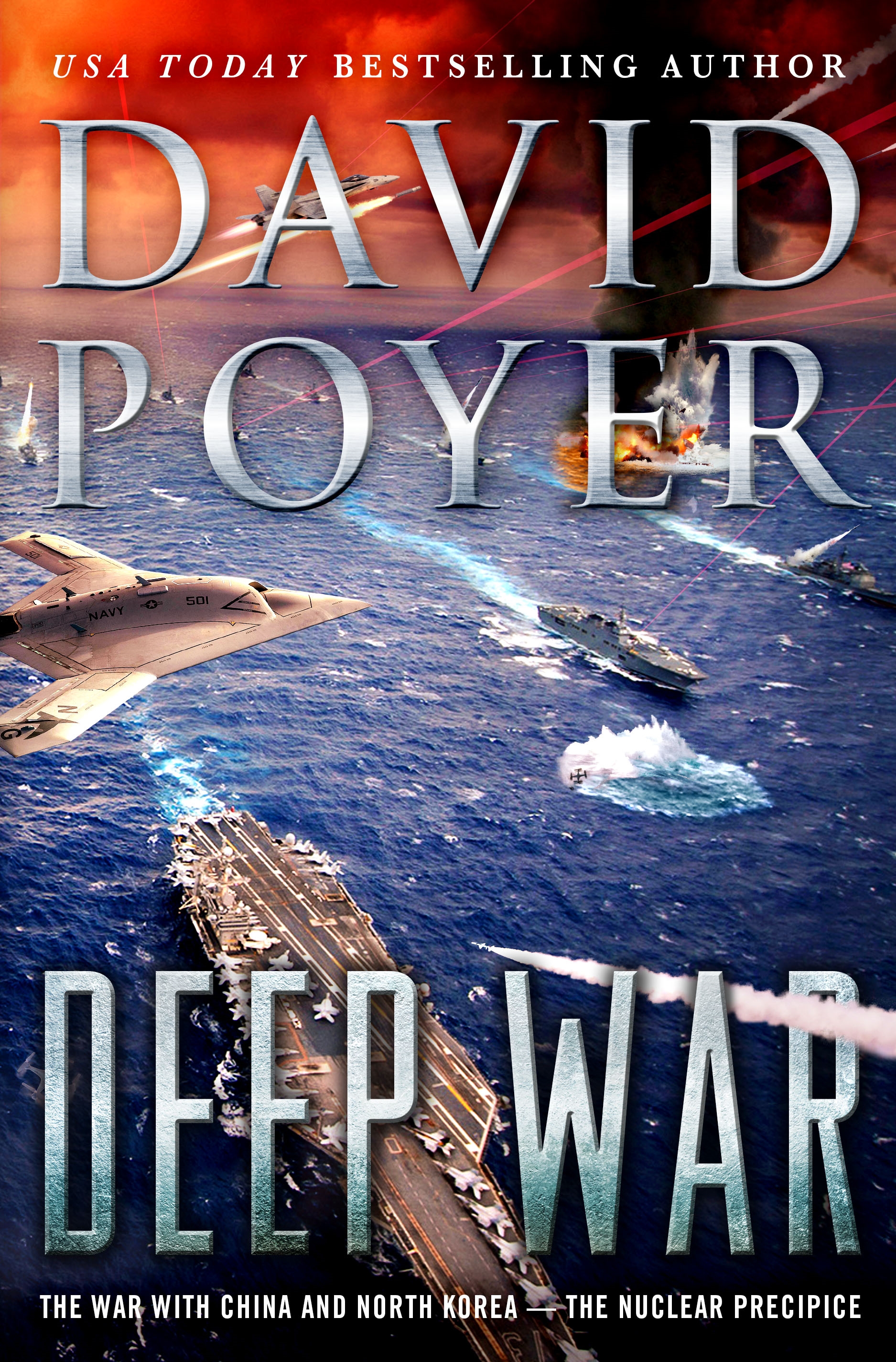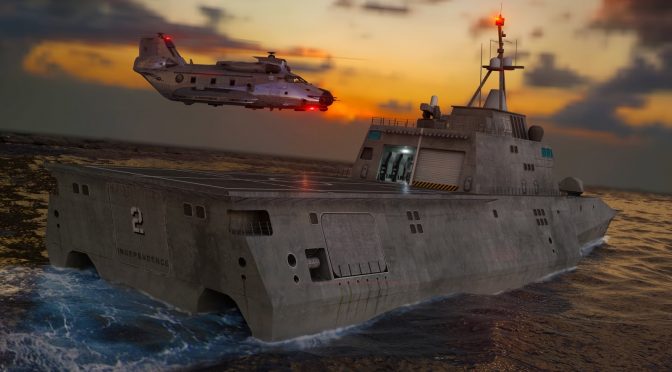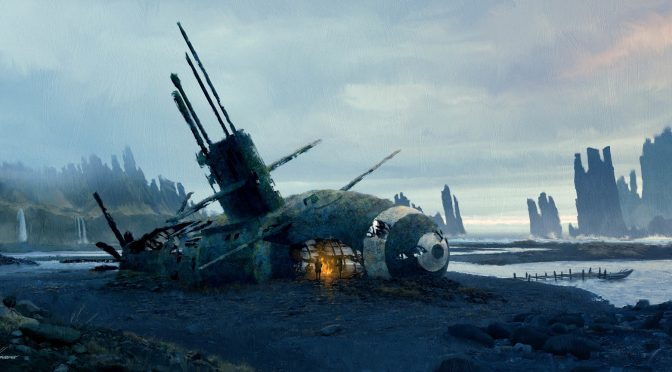By Michael DeBoer
I had the pleasure of speaking with author David Poyer, former naval officer and author of the Tales of the Modern Navy and War with China series of novels, and other exciting naval fiction titles. We discussed his newly released book in the War with China series, Deep War, how the trends of war are reflected in his writing, and how the main characters of a long series are taking on new roles.
(Read our previous interview with Poyer on his book Onslaught here.)
MD: A major feature of your work is the escalatory nature of war. You seem to be making the point that, given the escalatory nature of a war between nuclear powers, the use of nuclear weapons is likely or inevitable. Do you think the taboos regarding nuclear use are enough to maintain a conventional war between nuclear powers?
DP: Well, as one of my characters says, there is no historical precedent for war between two nuclear-armed powers. My own analogy is a knife fight in an alley, where both antagonists, in addition to knives, are carrying concealed firearms. Is the combatant who’s about to lose his life going to forego pulling his gun? I doubt it.
Limits have a way of getting transgressed in war. Unrestricted submarine warfare, use of gas, shelling and bombing cities . . . none of these red lines held when a regime felt its existence was at stake, and most were not merely “taboos,” but had been duly codified in international law signed by the warring parties.
So to answer your question, yes. As I have assumed in these novels, the danger of escalation is extreme.
MD: Tales of the Modern Navy was, until these chapters, slightly retrospective. They normally looked backward 5-10 years. However, starting with Tipping Point, we’ve moved into the future. What did you have to change about your writing process and style when you moved into the future? How did you prepare?
DP: That’s a perceptive question that goes back to the roots of my writing career. My very first published stories were science fiction, and so were several of my early novels: Stepfather Bank, White Continent, The Siloh Project, and others. So incorporating and extending technology into story hasn’t been a stretch for me.
The shift from mildly retrospective to near-future was crucial because although Dan’s several missions for the Tactical Analysis Group, for example, (Korea Strait, The Weapon, The Crisis, The Towers) were classified, and thus could be accepted by an informed audience as having happened even though they hadn’t heard about them on the evening news, we couldn’t slide a whole world war past them that they knew had NOT happened! The shift to a near future was the answer. And no special preparation was necessary; simply extending current political and technological trends a few years adds, I hope, enough credibility to make the story work. We’ll see in ten years how close I came – and of course, I’m hoping the dire events described in these volumes never happen!
MD: Technological development in Deep War is picking up speed. Lenson’s reality is now populated with Zumwalt-class follow-ons, directed energy weapons, increasingly sophisticated UAVs, successive blocks of F-35, integrated digital optics, and AI. Similar to Ghost Fleet, this cocktail produces a brutal combat environment in which few humans can survive. Do you have any thoughts on the future of warfare with all of these digitally enabled and augmented technologies? Are we coming around a corner similar to the First World War, when the technical capacity for killing exceeds our ability to innovate in a way that prevents attrition from becoming the decisive force in war?
DP: “Picking up speed” – sure, and I note in these novels that war is always a forced draft for technology. Still, though, that technology often fails you, especially in combat conditions, and I highlight that possibility in Hector Ramos’s experiences on Itbayat and Taiwan, as well as occasionally with the other characters. As for the technical capacity for killing exceeding the capacity to innovate in a way that bypasses attrition . . . I must disagree. Attrition was the decisive force in World War One. It was decisive in WWII as well. But innovation on one side, along with good strategy, can drive attrition rates on the other side. That is how they are related, I believe.
As to the future of warfare with these augmented technologies, these six books . . . The Cruiser, Tipping Point, Onslaught, Hunter Killer, Deep War, and next year’s Overthrow . . . address and describe the way I think warfare may evolve.
MD: I think I caught a little bit of Fahrenbach’s This Kind of War in Hector’s experience on Taiwan. Is that accurate, and are there any other books that inspired you in this work?
DP: Haven’t read Fahrenbach but thanks for the suggestion! Several pages of research articles, monographs, and a few books are listed in my acknowledgements at the back of each novel, along with shout-outs to those folks who advised me and read portions of the text to make sure I didn’t go completely off the rails. Many, many active duty and recently retired subject matter experts backstopped me and provided useful suggestions. I owe them a lot. Still, any errors and omissions are my responsibility.
MD: Deep War largely surpassed Daniel Lenson, who winds up being mostly an observer compared with Oberg, Staurulakis, and Hector. Have you considered writing works with any of them as the central figure?
DP: These novels are braided narratives, with different characters providing different views of the action. I call the story arcs of each protagonist a “strake,” in an analogy to ship design, with Dan serving as the keel. If you welded together the strakes for each character from succeeding books, you would have more or less the work you describe.
I employed different points of view for the same reason Tolstoy did it in War and Peace: a war is too geographically and emotionally sprawling an event to recount from one point of view.
A final reason for multiple characters was that Dan is getting pretty damn senior by now. We began the series with him as an ensign in The Circle. Now he’s a one-star, at least for the duration. But what that means is that as he ascends the ladder, it becomes more and more difficult to believably involve him in close-up dramatic situations. Most admirals I know would agree that their official duties are pretty unexciting from an action-adventure standpoint.
Thus, artistically, we had to transition Dan from an action hero to something more like a big-picture boss who functions less to take on bad guys hand-to-hand, as he did in earlier books, and more like the wartime leader who has to inspire, manage, and adapt fleet tactics to new threats and ways of fighting. That doesn’t mean the decisions he will make won’t be hugely significant and maximally stressful! He also shares with Blair Titus the coverage of overall strategy, although as a (increasingly reluctant) member of the administration she operates at an even higher level than he does.
MD: The title Deep War seems to be a homage to the Russo-Soviet pre-World War II concept of Deep Battle, a concept of operational warfare emphasizing penetration of enemy strategic depth. Was this intentional, and if so, who is waging the Deep War?
DP: Not really! Actually it’s a homage to Ilya Ehrenburg’s poem “The War,” where he wrote: “We speak of deep night, deep autumn; when I think back to the year 1943 I feel like saying “deep war.”” So it’s a literary reference that can be taken other ways as well. That I think is the best way to craft a title, with resonance that beckons the reader in, then reveals multiple meanings and associations as the book progresses.
MD: One theme that seemed to run through Deep War was the juxtaposition between Thucydides Whale and Elephant. By the time of your story, the United States has effectively denuded Chinese naval power, but can’t reach the land power’s center of gravity. Likewise, China, despite efforts through cyberspace, can’t reach the distant American center of gravity by conventional means. China has spent a lot of money and time trying to turn itself into a maritime power. Has it succeeded? Or will a Thucydides-type dynamic continue to hold true into the future?
DP: There are more elements to sustaining naval power than ships, or even a balanced fleet. Allies, technological depth, economic staying power, training, tactics, national determination, leadership, and geography are others. Right now we’re neglecting and even estranging our allies, but that can’t continue with any good end result for us. So, I assume in my writing that any fissures have largely been healed (though some allies are more allied than others). China’s increasing overreach and bullying of smaller nations will also contribute to a rebalancing of alliances.
But to return to your first question: the dire and unprecedented problem of how a war between two nuclear powers can be terminated resonates through the book. This is the crux of the dilemmas faced by Blair Titus, Dr. Szerenci, and Jay Yangerhans, and even certain elements within the Chinese leadership. They are searching more and more desperately as the conflict deepens and casualties mount for a way not necessarily to “win,” but to reach at least an armistice before escalation leads to mutual destruction. This is the real tension of the last two volumes of the War with China series, as I believe it’s the most likely way things would play out in the real world.
MD: Any final thoughts to share?
DP: In closing, I want to thank the many fans who’ve stuck with me through this series. I know it’s been frustrating at times to have to wait for the next volume in order to find out what happens to Teddy, Dan, Blair, Hector, Cheryl, and our other friends. Dark fates await some of them. Brighter days beckon for others. I too am just as impatient to find out how it all ends. Stay with me, as you so resolutely have so far, and we’ll all discover what lies at the end of their turbulent voyages!
David Poyer is the most popular living author of American naval fiction. His military career included service in the Atlantic, Mediterranean, Arctic, Caribbean, the Middle East, the Pacific, and the Pentagon. His epic novel-cycle of the modern military includes The Med, The Gulf, The Circle, The Passage, Tomahawk, China Sea, Black Storm, The Command, The Threat, Korea Strait, The Weapon, The Crisis, The Towers, The Cruiser, Tipping Point, Onslaught , and Hunter Killer (all available from St. Martin’s Press in hardcover, paper and ebook formats). Deep War, the latest in his War with China series, recently published on December 8. Visit him at www.poyer.com or on Facebook.
Michael DeBoer is a U.S. naval officer. The views herein are his alone and do not represent the views of the Department of Defense, the Department of the Navy, or any other organization.
Featured Image: Littoral Combat Ship by Matt Bell.




